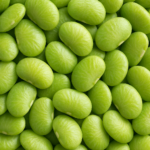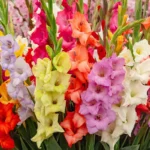
The California Poppy, known scientifically as Eschscholzia californica, is a striking wildflower that captivates with its vibrant orange blooms and delicate beauty. As California’s state flower, it holds a special place in the hearts of many and is celebrated for its resilience and adaptability to the state’s diverse environments. From its unique growth conditions to its cultural significance, the California Poppy is a fascinating subject that reflects the natural splendor and ecological diversity of California. Here are some intriguing facts about this beloved flower.
State Flower: The California Poppy was designated as the state flower of California in 1903, reflecting its iconic status within the state. This designation was part of a broader movement to recognize and celebrate California’s unique natural heritage. The flower’s vibrant orange color and delicate petals symbolize the beauty of California’s landscapes, particularly in spring when the poppies bloom across the state. The California Poppy is not only a representation of the state’s flora but also embodies the spirit of California, showcasing its diverse ecosystems and cultural significance.
Native Range: The California Poppy is native to the western United States and Mexico, with its primary range spanning from southern California to as far north as Oregon. This adaptability allows it to thrive in various habitats, from coastal regions to desert areas. The plant is particularly abundant in California, where it is found in grasslands, hillsides, and along roadsides. Its native range contributes to its status as a beloved symbol of California, as it is often associated with the state’s natural beauty and biodiversity.
Blooming Season: California Poppies typically bloom from February to September, with the most vibrant displays occurring in March and April. This blooming season is influenced by the local climate, particularly rainfall patterns and temperature. The flowers open during sunny days and close at night or during cloudy weather, creating a dynamic visual display. The timing of the bloom is crucial for pollinators, as it provides a vital source of nectar and pollen during the early spring months when other food sources may be scarce.
Height: California Poppy plants can grow between 12 to 18 inches (30 to 46 cm) tall, depending on environmental conditions such as soil quality and moisture availability. This height allows the flowers to be visible from a distance, creating stunning fields of orange that attract both human admirers and pollinators. The height of the plant also contributes to its resilience; it can sway with the wind without being easily damaged, allowing it to thrive in open fields and grasslands.
Color: The flowers of the California Poppy are usually bright orange, a color that has become synonymous with the state itself. However, variations can occur, with some flowers appearing in shades of yellow, cream, or even red. This vibrant coloration is due to the presence of carotenoid pigments, which not only attract pollinators but also provide a striking contrast against the green foliage. The vivid orange of the California Poppy is often associated with warmth and positivity, making it a favorite among gardeners and nature enthusiasts alike.
Flower Size: Individual California Poppy flowers can reach up to 3 inches (7.6 cm) in diameter, making them relatively large compared to other wildflowers. The size of the flowers allows them to capture sunlight effectively, which is essential for photosynthesis. Additionally, their size and bright color make them highly attractive to pollinators such as bees and butterflies, which play a crucial role in the plant’s reproduction by facilitating cross-pollination.
Seed Production: A single California Poppy plant can produce up to 25,000 seeds, a remarkable feat that ensures the survival of the species. These seeds are small, lightweight, and equipped with a hard outer shell, allowing them to be dispersed by wind and water. The high seed production rate increases the chances of germination in favorable conditions, contributing to the plant’s ability to colonize new areas. This prolific nature is particularly advantageous in environments where conditions can be unpredictable.
Seed Longevity: The seeds of California Poppies can remain viable in the soil for up to 10 years, allowing the plants to endure periods of drought or unfavorable growing conditions. This longevity is a survival strategy that ensures the species can rebound after adverse environmental events. When conditions improve, such as after significant rainfall, the seeds can germinate and produce new plants, contributing to the cycle of life in their native habitats.
Growth Habit: California Poppies are classified as annual plants, meaning they complete their life cycle within a single growing season. They germinate from seeds, grow, flower, produce seeds, and die all within one year. This growth habit allows them to take advantage of favorable conditions in their environment, such as seasonal rains, and quickly reproduce before the onset of harsher conditions. Their ability to thrive in a variety of soil types and conditions makes them a resilient species.
Root System: The California Poppy has a taproot that can reach depths of up to 2 feet (60 cm), enabling the plant to access deeper soil moisture during dry periods. This root system is crucial for the plant’s survival in the often arid environments of California. The deep taproot allows the California Poppy to establish itself in a range of environments, from coastal regions to deserts, where surface moisture may be limited. The taproot not only anchors the plant securely in the soil but also helps it withstand strong winds and other environmental stresses. This adaptability is a key factor in the California Poppy’s ability to thrive in diverse habitats and contributes to its status as a symbol of resilience in the face of changing conditions.
Pollinators: California Poppies are known to attract a variety of pollinators, including bees, butterflies, and hummingbirds. The bright colors and sweet nectar of the flowers serve as a significant food source for these creatures, particularly during the spring months when many plants are just beginning to bloom. Pollinators play a crucial role in the reproductive process of California Poppies, facilitating cross-pollination that leads to genetic diversity in the population. This relationship enhances the overall health and resilience of the ecosystem in which the poppies grow.
Habitat: California Poppies thrive in well-drained soils and are commonly found in grasslands, open fields, and along roadsides. They prefer full sun and can tolerate a range of soil types, including sandy and clay soils. These habitats provide the necessary conditions for the poppies to flourish, including adequate sunlight and minimal competition from other plants. The adaptability of California Poppies to various environments makes them a common sight in many parts of California, especially in regions that experience seasonal rainfall.
Cultural Significance: The California Poppy holds cultural significance beyond its status as the state flower. It is often associated with the Gold Rush era of the mid-1800s, symbolizing the hope and prosperity that drew many to California. The flower is also featured in various artworks, literature, and folklore, representing the beauty and spirit of the Californian landscape. Its vibrant blooms are celebrated in festivals and events, further solidifying its role as an emblem of California’s natural heritage.
Edibility: The petals of California Poppies are edible and have been used in various culinary applications, though they are not commonly consumed. Historically, Native Americans utilized the flower for its medicinal properties, incorporating it into their diets and traditional remedies. The petals can be used as a garnish or added to salads for a pop of color and a subtle flavor. However, it’s important to note that while the petals are safe to eat, the seeds and other parts of the plant may contain compounds that can be toxic in large quantities.
Medicinal Use: Historically, various Native American tribes used the California Poppy for its sedative properties. It was often employed as a natural remedy for ailments such as insomnia, anxiety, and pain relief. The plant contains alkaloids that can have calming effects on the nervous system. Today, some herbalists continue to use California Poppy in tinctures and teas for its mild sedative effects, although it is less common than other herbal remedies. Its historical use highlights the importance of the California Poppy in traditional medicine practices.
Record Bloom: The “super bloom” phenomenon occurs when California Poppies bloom en masse, creating breathtaking displays of orange across vast landscapes. This event usually follows periods of heavy winter rains, which provide the necessary moisture for the seeds to germinate and thrive. Super blooms are particularly spectacular in areas like Antelope Valley California Poppy Reserve, where visitors flock to witness the vibrant fields. These rare occurrences can attract significant attention and tourism, showcasing the beauty of California’s natural environment.
Environmental Indicator: The presence of California Poppies can indicate healthy soil conditions, as they thrive in environments with good drainage and nutrient availability. Their ability to flourish in disturbed soils also makes them a pioneer species, often colonizing areas that have been affected by human activity or natural disturbances. The health of California Poppy populations can serve as a barometer for ecosystem health, helping ecologists assess the impact of environmental changes and land use practices.
Conservation Status: While California Poppies are not currently considered endangered, some populations face threats from habitat loss due to urban development, agriculture, and invasive species. Conservation efforts are important to protect these beautiful flowers and their habitats, particularly in areas where they are at risk. Organizations and local governments often implement measures to preserve natural habitats and promote the growth of native plants, including California Poppies, to ensure their continued presence in the landscape.
Color Variations: Selective breeding has resulted in various cultivars of California Poppies that exhibit different flower colors and shapes. While the wild type is predominantly bright orange, cultivated varieties can be found in shades of yellow, cream, and even deeper hues. These variations are popular among gardeners and landscapers who seek to create colorful displays in their gardens. The diversity of cultivars also highlights the adaptability of the California Poppy to different growing conditions and aesthetic preferences.
Growth Conditions: The California Poppy (Eschscholzia californica) thrives in full sun, requiring at least six hours of direct sunlight each day to grow optimally. Once established, this resilient flower exhibits remarkable drought tolerance, making it well-suited for California’s arid climate. The plant has adapted to survive in poor, well-drained soils, often found in open fields and along roadsides. Its ability to withstand dry conditions is a key feature, allowing it to flourish in environments where other plants may struggle, thus contributing to its widespread presence in the wild.
Planting Depth: For successful germination of California Poppy seeds, it is recommended to sow them at a depth of approximately ¼ inch (0.6 cm). This shallow planting depth allows the seeds to receive adequate sunlight and moisture, which are crucial for germination. The seeds have a hard outer coating that can benefit from light exposure, as they often require specific conditions to break dormancy. Proper spacing is also important; planting them too closely can lead to competition for resources, while sowing them at the right depth ensures that they can establish strong root systems.
Flowering Duration: The California Poppy is known for its ephemeral beauty, as individual flowers typically last for only a few days. Each flower opens in the morning, basking in the sunlight, and closes at night, a behavior known as nyctinasty. This daily cycle allows the poppies to conserve moisture during cooler nighttime temperatures while maximizing exposure to sunlight during the day. The flowers’ vibrant orange petals create a stunning display that attracts pollinators, contributing to the plant’s reproductive success. This short-lived flowering period encourages a continuous blooming cycle throughout the growing season, especially in optimal conditions.
National Parks: The California Poppy is a prominent feature in several national parks, with the Antelope Valley California Poppy Reserve being one of the most famous locations to witness these blooms. This reserve, located in Southern California, is dedicated to the protection and conservation of the California Poppy and its unique habitat. Each spring, the reserve comes alive with vibrant fields of orange, drawing visitors from around the world. The park not only serves as a sanctuary for the poppy but also provides educational opportunities about the region’s ecology and the importance of preserving native plant species.
Cultural Festivals: The California Poppy Festival, held annually in Lancaster, California, celebrates the beauty and cultural significance of this iconic flower. This lively event typically features a variety of activities, including art exhibits, live music, food vendors, and educational workshops focused on the importance of the California Poppy in local culture and ecology. The festival draws thousands of visitors each year, promoting community engagement and appreciation for the natural beauty of the region. It serves as a reminder of the flower’s status as California’s state flower and its role in the state’s identity and heritage.
Color Representation: The vibrant orange hue of the California Poppy is rich in symbolism across various cultures, often representing warmth, energy, and optimism. This bright color not only attracts pollinators but also evokes feelings of joy and positivity. In many cultures, orange is associated with creativity and enthusiasm, making the California Poppy a fitting emblem for the spirit of California. The flower’s striking color has inspired artists, poets, and photographers, serving as a muse for creative expression and a symbol of the beauty found in nature. Its presence in gardens and landscapes further enhances the aesthetic appeal, bringing vibrancy and life to outdoor spaces.
California Poppy FAQs
General Questions
1. What is a California Poppy?
- A California poppy (Eschscholzia californica) is a native wildflower to California, known for its vibrant orange petals and delicate appearance. It’s the state flower of California.
2. Where do California Poppies grow?
- California poppies thrive in sunny, dry conditions and are commonly found in meadows, hillsides, and along roadsides throughout California. They can also be grown in gardens with well-draining soil.
3. When do California Poppies bloom?
- California poppies typically bloom in the spring and early summer, but they can rebloom throughout the year, especially in areas with mild climates.
4. How long do California Poppies bloom?
- The blooming period of California poppies can vary depending on weather conditions and overall plant health. They can bloom for several weeks or even months.
5. What color are California Poppies?
- While the most common color for California poppies is orange, they can also be found in other shades, including yellow, white, pink, and even red.
Growing California Poppies
1. How do I grow California Poppies?
- California poppies are easy to grow from seeds. Simply sow seeds directly into the soil in a sunny location. They prefer well-draining soil and do not require heavy fertilization.
2. Can I grow California Poppies indoors?
- While it’s possible to start California poppies indoors, they are better suited for outdoor growing conditions. They prefer bright, indirect light and well-draining soil.
3. How do I care for California Poppies?
- California poppies require minimal care once established. They are drought-tolerant and do not need frequent watering. Regular deadheading can encourage continuous blooming.
4. Can I plant California Poppies with other plants?
- Yes, California poppies can be planted with other drought-tolerant plants, such as lavender, rosemary, and sage. They can also add a splash of color to vegetable gardens.
Cultural and Symbolic Significance
1. What is the significance of the California Poppy as the state flower?
- The California poppy was chosen as the state flower in 1903 to represent the state’s beauty, abundance, and resilience. It is a symbol of hope, optimism, and the golden state itself.
2. Are there any cultural or historical associations with California Poppies?
- California poppies have been used by Native American tribes for medicinal purposes and in ceremonies. They have also been associated with the California Gold Rush, symbolizing the state’s natural wealth and abundance.
3. What does the California Poppy symbolize in literature and art?
- The California poppy has been featured in numerous works of literature and art, often representing themes of beauty, fragility, and the ephemeral nature of life.








